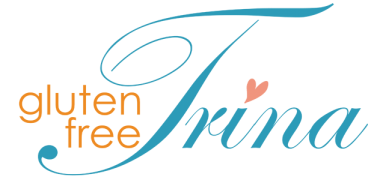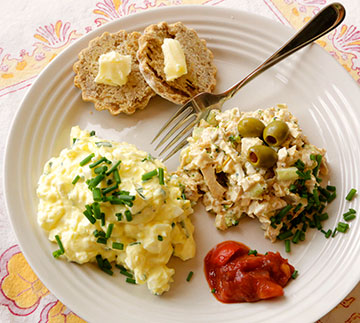There are many things to consider when setting up your new gluten-free kitchen. Here are some ideas to help you accommodate a gluten-free diet in your home.
- How to begin and live a successful gluten-free life.
- How to changeover your kitchen and to what degree.
- How to promote understanding with others in the household.
Communicate and Promote Understanding
Changing to a gluten-free lifestyle can be unnerving initially, but in today’s world, it is much easier than it used to be. Nevertheless, caring and consideration are most important for all those involved in your household.

If you or a member of your family are new to the gluten-free diet, here are some changes you will need to consider. A gluten-free diet is a long-term health commitment if you have been diagnosed with Celiac or Gluten-Sensitivity. It does not have to be a sad change. You can live an awesome life without gluten!
Being Considerate
One of the biggest things to consider is not making those who are gluten-free feel second-class or deprived. But this can happen on both sides. Those who don’t have to eat gluten-free need to be considered and be able to eat gluten-full items they enjoy. This can all be worked out once everyone understands how important this diet is to the Celiac or Gluten-Sensitive person.
Make eating enjoyable for everyone. Find new ways and recipes to have fun with food. Many ethnic dishes are tasty and traditionally gluten-free, which the whole family will enjoy. If you focus on healthy, whole, and unprocessed foods and cooking from scratch, you may find this diet to benefit everyone. It is easier for someone who can eat gluten to add other foods into their diet that are not gluten-free than it is to eliminate gluten for those on this diet.
Decide to what degree your home will be gluten-free or shared gluten-free.
Here are some suggestions to help you decide what is best for your lifestyle. Perhaps you are newly beginning on this path, or you are starting again to make your kitchen and food preparations safer and more streamlined. Being organized makes everything easier for everyone in your home. You have choices!
- 1. The All Gluten-Free Home
- 2. A Mostly Gluten-Free Home with the Addition of Gluten-Full Foods for some.
- 3. The Evenly Divided Kitchen between Gluten-Free and Gluten-Containing Foods.
Questions to Consider
- How many people are there in your household, and what proportion need to eat gluten-free?
- Who is the main cook and baker in your home? Are they the ones needing to eat Gluten-Free?
- Is the gluten-sensitive or celiac a child? What age group the individuals are in can determine many of the food choices.
- Are there other food sensitivities to consider? For the gluten-free person or another person?
- Does more than one person prepare meals? Do you take turns? You can choose a cooking schedule for different days or meals during the week.
- Preparing meals ahead of time and storing them separately or freezing some things can make quick meals easier.
- Do you usually cook together as a couple or as a family?
Some families enjoy cooking and baking together. How will you manage these times? - Do you have enough kitchen space to store additional food, cooking equipment, and utensils? Many kitchen items we take for granted can have hidden traces of gluten that can’t be cleaned easily.
- Financial considerations are always a consideration. Make a plan that can be implemented over time and save you money.
- Make everyone in your household aware of the long-term health consequences for your family member. Although this is not like a peanut allergy, where the person can have an immediate life-or-death reaction, the long-term consequences of ingesting gluten are progressive and can do damage.
1. The All Gluten-Free Home – How to Begin
First of all, if you are new to the gluten-free diet, you need to re-organize and, in general, purge everything that is not gluten-free. There is no need to waste food. You can give away the items that will cause you any distress to family or friends who can eat gluten. If you are a frugal person, you may need just to close your eyes and throw things out. It is not worth the risk.
Please note: In the early days of going gluten-free, we can convince ourselves that just this once a little won’t hurt. For some of us, gluten can be like an addiction. We really want it, and if it is there and we feel hungry, we might cheat. Feeling hungry needs to be avoided. It can take some time before we recover enough to feel so good that we never want to jeopardize that good feeling again.
Next, you will need to inventory the items you use to cook with. What can be cleaned sufficiently, and what will have to be exchanged for new?
Give your kitchen an extreme cleaning. All counters and preparation surfaces need to be cleaned and disinfected thoroughly. Clean out and wash your cupboards. Remove gluten-containing items and wash out your refrigerator. You can reserve some foods in containers in the fridge that you label as off-limits. Clean your kitchen stove and oven.
Please note that something must be washed more than once to be thoroughly cleaned of gluten. Trace amounts of gluten can stick to surfaces. Dishes and cutlery are not as difficult as long as you have a dishwasher that will rinse well and you pre-rinse. If washing both gluten-free and gluten-full together
by hand, you will need to give them a double wash with hot soapy water and a good rinse.
Cupboards and any storage items that have been used to contain food must be totally cleaned. Wash with soapy water, rinse, and dry.
Decide what to do with kitchen appliances that cannot be cleaned sufficiently. See the lists below.
2. A Mostly Gluten-Free Home with the Addition of Gluten-Full Foods for some.
If you are going to share your kitchen with those who are gluten-free and also not on this diet, you should decide to what degree you will have a gluten-free kitchen. It can be easy to manage if your kitchen is mostly gluten-free, with only adding gluten-full items occasionally.
How to store food for both gluten-free and gluten-full foods
- Clean your kitchen as above and separate areas to store foods.
- Organize separate areas in your kitchen cupboards that will be conducive to keeping foods separate from each other to avoid cross-contamination.
- Decide on a labeling system that works best for you.
Masking Tape, you can write on.
Black Markers to write directly on boxes or bags
White Crack and Peel labels you write on
Color Coded labels
A Label Maker
Post-It Notes (these can fall off) - Be aware that crumbs and small particles from wheat or gluten-full items can be a health hazard. Store any items that are gluten-free above or away from gluten-full items. Try to have separate cupboards or enclosed see-through small bins for storage.
- Determine certain areas for gluten-free food preparations with separate cutting boards and other food prep items.
Cooking Equipment and Utensils
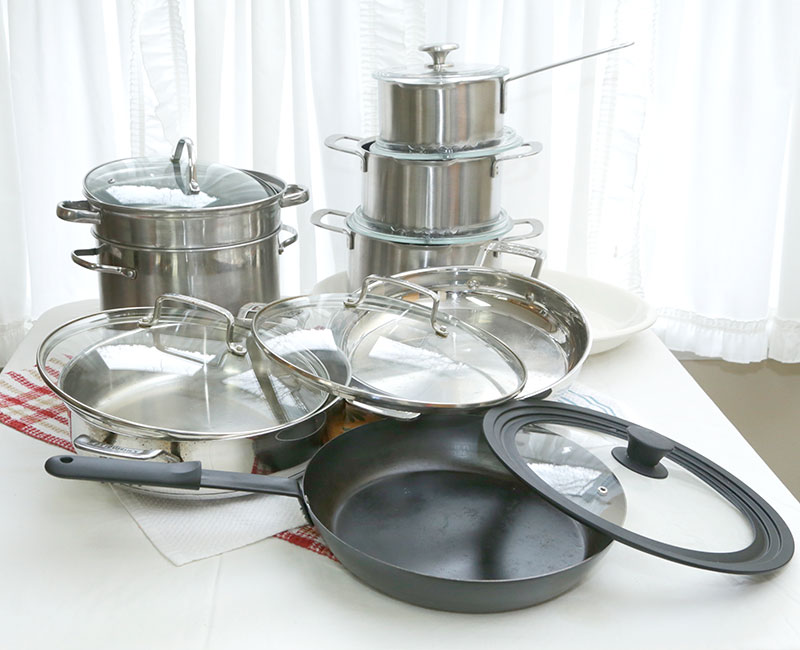
- The Regular Pop-Up Toaster – Because it is impossible to keep wheat bread crumbs away from gluten-free bread, keep your old toaster only for wheat.
- Gluten-Free Bread often comes in various shapes, and a Toaster Oven is a better choice for heating gluten-free bread and buns. It is also useful for more than toast, such as re-heating foods and even baking smaller amounts as needed. It should be dedicated to gluten-free since crumbs are inevitable. Tinfoil over one rack can make cleanup easier.
- Keep pots, pans, and skillets divided for gluten-free use or not. These can be more difficult to clean each time sufficiently. Use non-porous cooking utensils for gluten-free. Non-stick items should be dedicated gluten-free or not used. Stainless steel pans can be washed sufficiently so that you don’t have to have two of everything. However, this can be determined by usage.
- Plastic Bowls, Colanders, and Seives can develop scratches that harbor trace gluten. These should be either dedicated to gluten-free food preparation or not used.
- Previously used or non-dedicated porous storage, cooking, and baking materials such as plastic, vinyl, and wood will need to be replaced. Non-stick skillets and pans with scratches are unsafe as gluten gets into those scratches and sticks.
- Bowls and cooking or baking utensils made of Glass, Metal, and Pyrex are fine.
- Metal Baking Pans are difficult to clean. Baked-on areas in the corners and joints can be hidden. Reserve baking pans to be used only gluten-free. Parchment paper used as a liner can also help. Glass baking pans are easier to clean.
- Utensils such as spatulas, spoons, and tongs used should be either made of easily cleanable materials or not used. Wooden spoons, for instance, should only be used if dedicated gluten-free.
- A metal whisk is a useful utensil for beating and mixing, and it can be cleaned thoroughly, either by hand or in the dishwasher.
Other items that could harbor traces of gluten
- Coffee Grinder – these are particularly useful for grinding flax and other seeds often used in gluten-free baking.
- Food Processor
- An Immersion Blender
- A Mixer for Beating
- Smoothie maker
- A Food Frier is hard to clean sufficiently.
- Utensils for prep areas include bowl scrapers, wooden or plastic cutting boards, and the like.
3. The Evenly Divided Kitchen between Gluten-Free and Gluten-Containing Foods.
This can be the most difficult of arrangements since you must be more vigilant about all aspects of food preparation and storage. Use the preceding lists and suggestions to help you decide. In effect, you may need two of everything, which will require more space and separate food prep areas. It can be done.
- Designate separate food prep areas. … Keeping things clean, neat, and in their own places will mean less accidental glutening.
- Lightly hand-wash dishes and cutlery before they go into the dishwasher.
- Parchment paper is a wonderful thing to help keep your kitchen gluten-free. It can be used for so many things.
- Family-style meals may require separate plates that are always used for gluten-free so that those members of the household know that food served on these will be safe for them. Here is a How To Article.
Stocking Your Refridgerator
The same principles apply when placing foods in your refrigerator. You must label foods well. Always try to keep gluten-free items on the top shelves so that crumbs will not fall into their space. If your home is all or mostly gluten-free, your fridge will be easier to manage. In any case, managing a safe fridge will require cleaning more often.
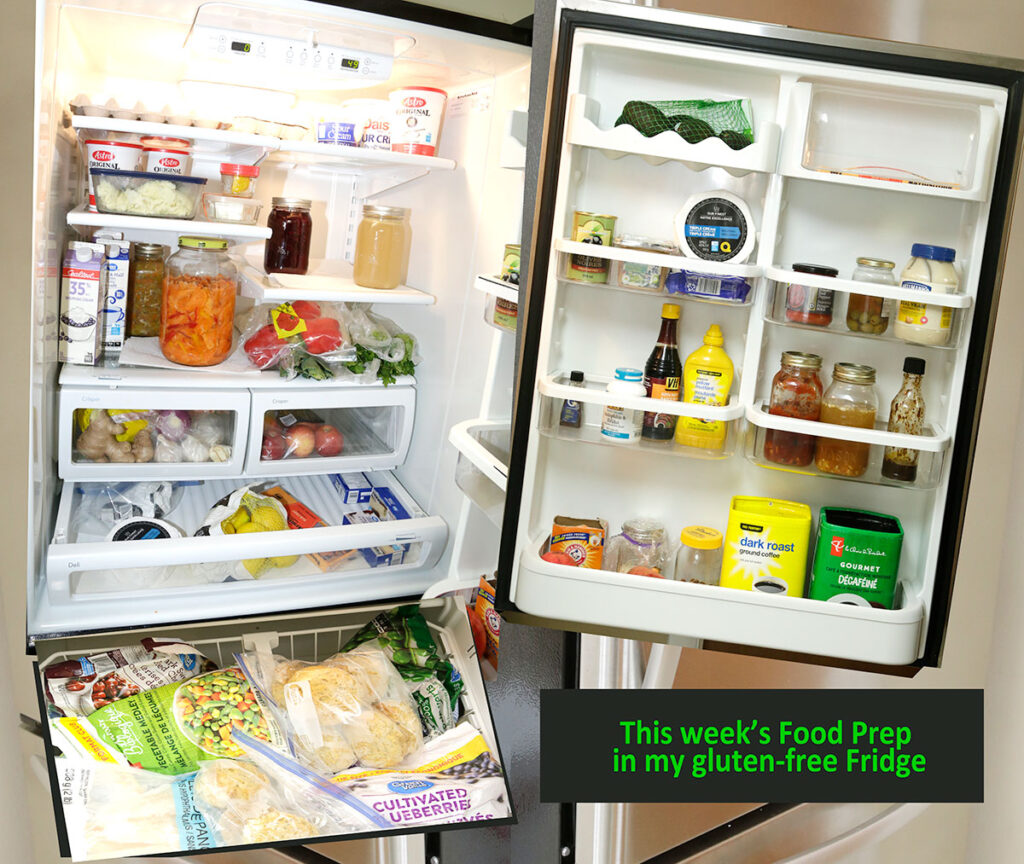
The above photo shows you what is in my fridge this week. Here is a list to make it easier to see what I was prepping for this week. Upper Left photo, from the top shelf down. Eggs, sour cream, yogurt. More yogurt for smoothies at the back. Leftover mashed potatoes in the glass container from last night’s supper, half a lemon, and cream cheese. Mason jar of the rest of the homemade Red Cabbage-Beet Kimchee. Mason jar clear chicken soup broth. 35% Cream and Half and Half. Mason jar at the back, vegetable soup. Large orange bottle, a new recipe I developed to add more beta-carotene to our diet. It is a Sweet potato and Carrot Kimchee. It is a success since we can’t wait to eat it and have been having a spoonful every morning at breakfast. Red Peppers, Leeks, Celery, White Raddish. In the crisper, whole ginger root, garlic, and carrots hiding behind them. Apples in the right-side Crisper. Lemons, Brie, and other cheese in the Deli drawer. There is some frozen fish, mixed vegetables, cherries, and blueberries in the freezer drawer. My gluten-free homemade buns are sliced and ready to toast for breakfast each morning.
In the side door on the right of the photo is a bag of ripened avocados waiting to be added to meals, more cheese, a tin of unopened olives chilling, Miso, butter, a jar of roasted red peppers (the ones I roasted last fall are all gone now) and an open jar of olives, and Mayonnaise. Next, a small bottle of pure vanilla extract, a bottle of lactobacillus acidophilus, gluten-free VH soy sauce, and mustard. In the mason jars are my homemade chili sauce, nasturtium, and squash blossom vinegar made from last summer’s garden—a small bottle with the remains of some gluten-free Mexican spice blend. Last week we had Mexican food. It all got eaten before photos—next time. Then baking soda to absorb the fridge odors and a half bottle of yeast for my bread baking and, of course, Coffee!
In our home, I am the one mostly in charge of food preparations. I like clearing out a fridge and using any leftovers before shopping. Then I clean the fridge and shop. Putting things away is easier. I also like to cook ahead, so I have many glass food storage containers with lids. Actually, I have a dedicated gluten-free home. So much easier! But we have holidayed with family who is not gluten-free and rented furnished cottages. This requires a lot of planning, and I bring as much of my own things as possible. But each time, I have learned a new trick or two to be able to consider everyone’s mealtime needs. Often I have volunteered to do the cooking. I enjoy it and have always taken into consideration the likes, dislikes, and food sensitivities of others.
Shopping for Gluten-Free Food
Make a list of the favorite foods of all the members of your household. It helps to keep a file of your guests’ preferences and other food sensitivities. For instance, one friend who often comes to eat at our house is not gluten-free but cannot have any cinnamon as she is allergic to it. Another can’t have nutmeg. Another does not like peppermint. The list can grow.
You will need to know what foods are just disliked. You can avoid them or try to make them more palatable. For instance, someone in our house does not like cauliflower. But when I serve it with lots of cheese sauce, they will eat a little.
Some foods are only occasional treats. Family dinners on holidays need extra planning.
Everyone needs to eat healthy foods.

- Vegetables – Greens, Yellow, Orange, Purple.
Fruit
Meat
Organ Meats
Fish
Poultry
Dairy
Eggs
Naturally GF Grains
Rice
White Potatoes
Sweet Potatoes
Gluten-Free Pasta
- Nuts and Seeds
Beans, Lentils, and Legumes
Condiments
Seasonings and Spices
Pickled and Fermented - Gluten-Free Bread
Baked Goods
Desserts
Treats - Liquids – Water
Coffee, Tea, Juice
Some naturally gluten-free flours, such as Sorghum, Quinoa, Buckwheat, Amaranth, Chickpea, and Cassava flour, can be used to add nutrition to your gluten-free baking.
Try to prepare and eat more naturally gluten-free foods, and avoid too many processed foods. Think of more nutritionally dense foods, and learn more about the nutritive elements of what you buy.
Research Ethnic recipes that are made with gluten-free ingredients.
Read the labels.
Remember, anything that is processed can have gluten in it.
Look for the Gluten-Free Symbol to make sure it is safe.
Plan Ahead
- Plan meals to cook and bake ahead of time and add fresh when prepping.
- Have a gluten-free cookbook on hand with recipes you can make. Find a recipe repertoire that you can always use and then add to it for variety.
- Always have something you can eat available when it is hard to cook or bake and or you don’t have time.
- Prepare and Cook to Avoid Cross Contamination.
- Learn what to ask for when you eat out. Prepare an information sheet.
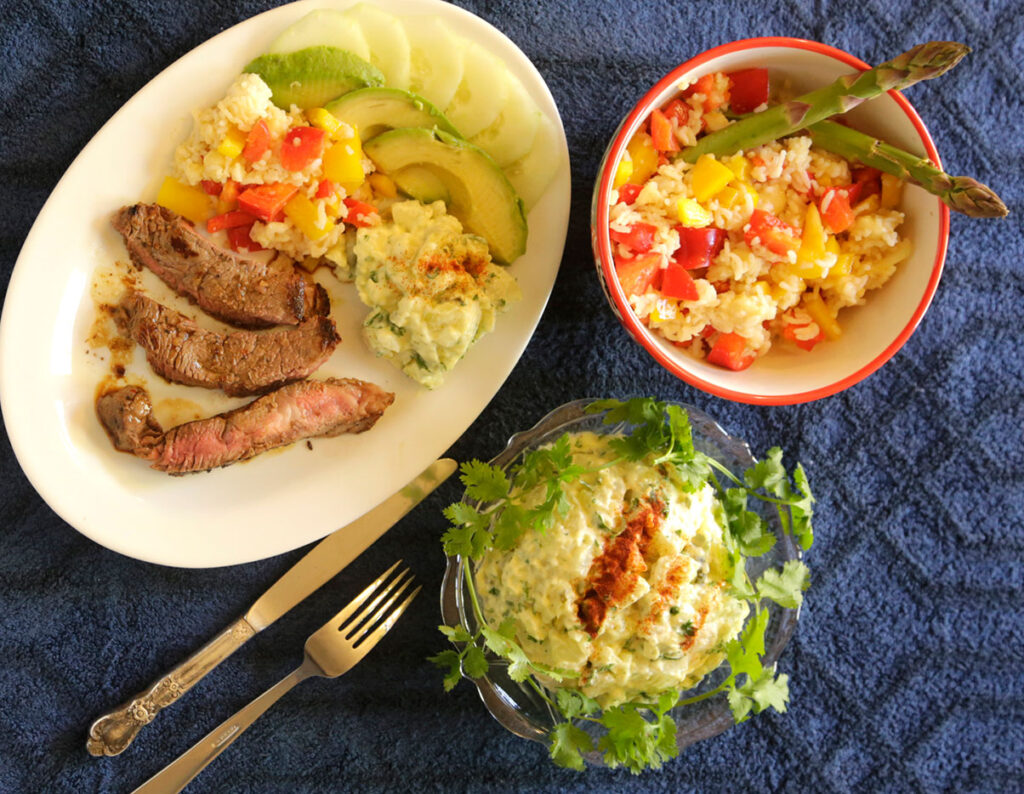
– food and photo by Trina Astor-Stewart – See the Recipes
Seek Advice from Professionals
It is not easy to set things up initially, and sometimes, you may need periodic help with meal planning and adding more nutritious foods to your menus. It is a good idea to seek the help of professionals.
Please note that as much as I want to help you with this information, it is only a good place to start. My advice is based on my own experience, as I am not a health professional or dietician.
“I hope I can help you with the many things I have learned from my gluten-free life. For over twenty years, I have been managing a gluten-free home, cooking and baking for others, photographing foods in my kitchen
Trina Astor-Stewart
and writing cookbooks.”
Gluten-Free You Can Do It
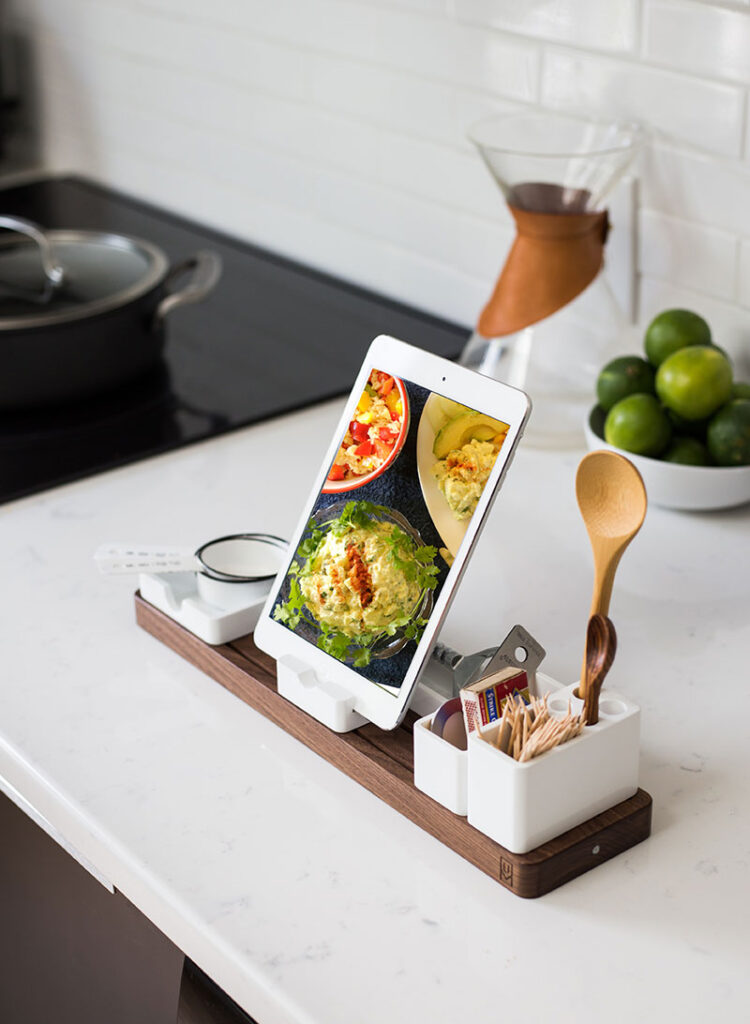
with ebook inset photo by Trina Astor-Stewart
